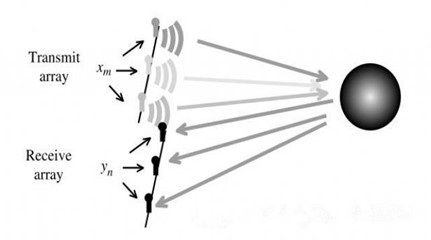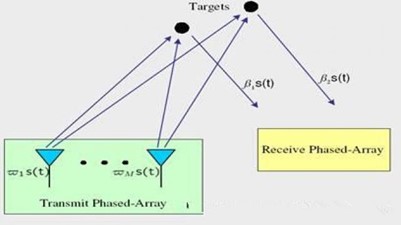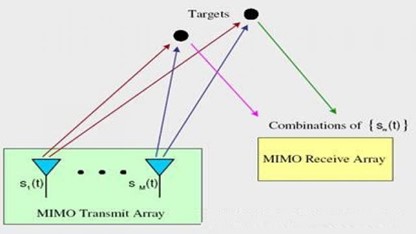The advantages of multi input multi output radar
Multiple Input Multiple Output (MIMO) was originally a concept originating from control systems and later introduced into mobile communication systems. Given that radar echo signals have some characteristics similar to mobile communication channels, MIMO technology has also been extended and applied to fields such as radar signal reception, target detection, and radar imaging.
In MIMO radar systems, multiple transmitting antennas are used to simultaneously send mutually orthogonal signals and scan targets. Subsequently, multiple receiving antennas capture the signals reflected back from the target and process them to obtain relevant data such as the target’s position information and motion status.
MIMO radar has the following advantages:
- The ability and reliability of target detection: MIMO radar enhances the detection capability of targets and the overall reliability of the system by using multiple antennas to simultaneously transmit and receive signals.
- Accuracy of target parameter estimation: Due to the ability of MIMO radar to collect information from multiple angles, it can provide more accurate target parameter estimation, such as the distance, velocity, and angle of the target.
- Resolution ability for multiple targets: MIMO radar can distinguish multiple targets in complex environments, improving the system’s resolution ability in dense target environments.
- Reduction of ambiguity in target parameter estimation: The design of MIMO radar reduces uncertainty in parameter estimation, making the judgment of target characteristics more accurate.
Different signals in MIMO radar systems can be separated through time domain, spatial domain, or polarization domain. This design increases the dimensionality of signal processing, making the utilization of transmitting and receiving apertures more efficient and enabling higher angular resolution.
In addition, MIMO radar utilizes the decorrelation characteristics of echo signals caused by the spatial diversity of target scattering, which can stabilize the average received energy of echoes (i.e. smooth the radar cross-sectional area [RCS] of airborne targets), thereby reducing the fluctuation of target RCS, improving detection performance and spatial resolution of targets.

MIMO radar emits signals that are orthogonal to each other in all directions, resulting in multiple transmission waveforms that cannot undergo traditional beamforming in space. This characteristic reduces the main lobe gain of the transmitted beam to 1/M of its original value (where M is the number of transmitting antennas). At the same time, the transmission power of each subarray is reduced to 1/M of the original total transmission power, resulting in a power density at distance R that is only 1/M of the original density. Considering the attenuation relationship of power with the square of distance, this configuration significantly enhances the radar’s ability to intercept adversarial signals.
At the receiving end, each element of the MIMO radar receives all the transmitted signals and separates them through a matched filter bank to obtain multiple echo signals. This method introduces observation channels and degrees of freedom that far exceed the actual number of physical array elements, greatly enhancing the overall performance of the radar compared to traditional single/multi base radar or phased array radar.
Due to the existence of multiple parallel spatial observation channels, MIMO radar can collect real-time echo data carrying different amplitude, delay, or phase information about the target. The ability to obtain parallel multi-channel information is one of the core advantages of MIMO radar, which makes it perform well in target detection and recognition.
The difference between MIMO radar and traditional array radar
The array radar system consists of multiple non directional antennas located in adjacent areas, which can both transmit and receive signals. In the transmitting or receiving array, the signals between each element have a high degree of correlation, which can form multiple beams comprehensively and scan the entire airspace simultaneously. However, its performance is affected by fluctuations in the target radar cross section (RCS). Any subtle changes in distance or orientation of the target may result in a significant increase or decrease in its reflected energy, making the target potentially undetectable.

MIMO statistical radar separates the sensors of the transmitter and receiver, where the spacing between the antennas in the sensor array of the transmitter is large enough to generate angular broadening effect (i.e. spatial diversity) on spatial targets. In contrast, the antenna spacing in the sensor array of the receiver is relatively compact, mainly used for directional measurement. The combination of each transmitting antenna and receiving antenna forms a MIMO subchannel, and the signal achieves decorrelation between different transmitting/receiving channels (i.e., between different MIMO subchannels). In this way, the average received energy of the echo is close to a constant, which means that the echo signal approximately maintains the basic invariance of the radar cross section (RCS).

MIMO Array Earth Observation Imaging Radar (MIMO-SAR)
The MIMO-SAR radar formed by combining MIMO radar technology with synthetic aperture radar (SAR) systems can effectively solve several technical problems in traditional SAR systems, especially the contradiction between high azimuth resolution and large mapping bandwidth in pulse repetition frequency (PRF).
In traditional SAR, a lower PRF is required to prevent distance ambiguity; However, in order to achieve high resolution in azimuth, a higher PRF is required to avoid Doppler blurring. The application of MIMO technology makes it possible to simultaneously meet the requirements of large surveying bandwidth and azimuth Doppler free ambiguity at lower PRF.
Thanks to the parallel multi-channel spatial sampling capability of MIMO radar, MIMO-SAR radar can obtain MN directional spatial sampling data in one pulse transmission process (M represents the number of transmitting antennas, N represents the number of receiving antennas). If the data of these MN channels is uniformly and non overlapping in the azimuth direction, the PRF required by MIMO-SAR radar can be reduced to 1/(MN) of traditional SAR systems. This not only solves the selection problem of PRF, but also improves the efficiency and performance of the radar system.
Three dimensional imaging of MIMO array
Currently, 3D SAR imaging can achieve height measurement by combining 2D SAR technology with interferometry. However, the combination of MIMO array with fewer antennas and SAR technology for 3D imaging is becoming an attractive research direction.
This method is not only expected to simplify the complexity of 3D imaging systems, but also to improve imaging efficiency and quality through the parallel multi-channel spatial sampling capability of MIMO radar. By optimizing antenna configuration and signal processing algorithms, MIMO-SAR systems have the potential to achieve finer 3D imaging while reducing hardware costs and operational complexity. This provides new possibilities for the future development of radar technology, especially in application scenarios that require high-precision 3D terrain information.
